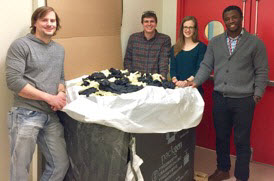The Scientist's Role in Laboratory Sustainability Efforts
Environmental stewardship in the lab

When it comes to creating a more sustainable world, discoveries don’t happen overnight. Any scientific breakthrough is an accumulation of many small, collaborative efforts often carried out over months or years, requiring expertise across multiple disciplines. The challenges that summon these resources are significant. Here’s the problem: one thing that’s guaranteed to accumulate during that time is lab waste.
For instance, laboratory plastic accounts for 5.5 million tons of plastic waste each year. That's 83 percent of the total plastic recycled worldwide—equivalent to the weight of 67 cruise liners. Additionally, labs consume as much as five times more energy per square foot than do typical offices due to energy-intensive equipment. One ultralow-temperature freezer uses as much energy as does a single-family home. Even the most humble accessory of the laboratory— the lab glove—is implicated in wasteful practices.
 Over 400 pounds of gloves were collected in the MIT Department of Chemical Engineering and Green Labs Program from July to December 2016. Uncontaminated nitrile and latex gloves are collected in a cubic yard box and sent to Terracycle. The gloves are then “upcycled” into new materials such as park benches. Left to right: Brian Smith, EHS coordinator; Thomas Carney, graduate student; Lisa Anderson, postdoctoral researcher; Kosi Aroh, graduate student, Department of Chemical Engineering, MIT.Photo credit: Nicole KelesogluAs I explained in my recent talk at the Passion in Science Awards hosted by New England Biolabs, Inc. (Ipswich, MA), innovation in sustainability doesn’t come solely from dramatic approaches and new technology. It can come from a small shift in how laboratory practices are performed. For example, it’s good lab practice to throw away biologically or chemically contaminated gloves. However, that practice can become a problem when applied to non-contaminated gloves as well. While pursuing my PhD at the University of California, Davis, I helped implement the first university glove recycling program, which could “upcycle” uncontaminated gloves into new materials such as park benches and chairs. In 2015, the ongoing program diverted more than two tons of lab gloves.
Over 400 pounds of gloves were collected in the MIT Department of Chemical Engineering and Green Labs Program from July to December 2016. Uncontaminated nitrile and latex gloves are collected in a cubic yard box and sent to Terracycle. The gloves are then “upcycled” into new materials such as park benches. Left to right: Brian Smith, EHS coordinator; Thomas Carney, graduate student; Lisa Anderson, postdoctoral researcher; Kosi Aroh, graduate student, Department of Chemical Engineering, MIT.Photo credit: Nicole KelesogluAs I explained in my recent talk at the Passion in Science Awards hosted by New England Biolabs, Inc. (Ipswich, MA), innovation in sustainability doesn’t come solely from dramatic approaches and new technology. It can come from a small shift in how laboratory practices are performed. For example, it’s good lab practice to throw away biologically or chemically contaminated gloves. However, that practice can become a problem when applied to non-contaminated gloves as well. While pursuing my PhD at the University of California, Davis, I helped implement the first university glove recycling program, which could “upcycle” uncontaminated gloves into new materials such as park benches and chairs. In 2015, the ongoing program diverted more than two tons of lab gloves.
In partnership with the Environmental Health and Safety Department at MIT and the nonprofit My Green Lab, I’ve spearheaded initiatives to “green” research spaces by reducing hazardous waste and emissions, conserving water and energy, and recycling. The MIT Green Labs team has engaged research colleagues from across engineering and science disciplines to join in making their labs more sustainable. In just a few months’ time, the eight labs involved have collected over 400 pounds of gloves, which will soon find their way into useful new products thanks to the upcycling program at TerraCycle (Trenton, NJ), which provides free waste collection programs for hard-to-recycle materials. Additionally, through other eco-sustainable practices such as maintaining ultralow-temperature freezers at -70°C instead of -80°C, the lab coalition has collectively saved over 30,000 kWh in electricity and 80,000 gallons of water—a real savings of $6,500 and the mitigation of 60,000 pounds of CO2 .
The scientific establishment— whether academia or commercial—isn't acquitted from eco-sustainability. We need role models of environmental stewardship to help encourage a path toward a greener laboratory. Most important, we have an obligation to educate the next generation of scientists on how their laboratory practices and daily habits have the potential to change the world.
As a postdoctoral scholar in Professor Kristala Prather’s lab at MIT, Dr. Lisa Anderson is working toward the development of novel bio-based chemicals for use in industrial applications. Her dedication to improving sustainable, energy-efficient laboratory practices has led to multiple awards, including the 2016 New England Biolabs Passion in Science Award for Environmental Stewardship, the Albion College Young Alumni Award, and a position on MIT’s Climate Action Advisory Committee, whose bold agenda seeks to reduce MIT’s carbon emissions 32 percent by 2030.

